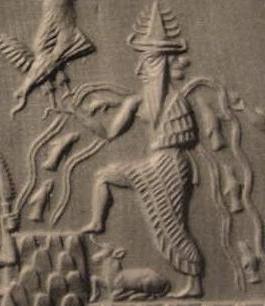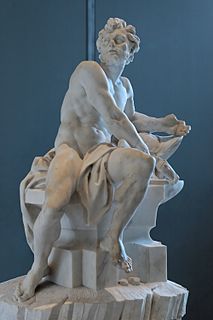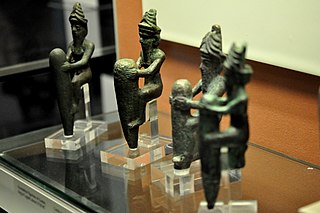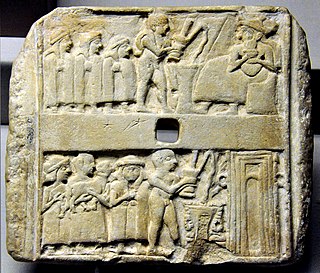Related Research Articles

Enki is the Sumerian god of water, knowledge (gestú), mischief, crafts (gašam), and creation (nudimmud), and one of the Anunnaki. He was later known as Ea in Akkadian and Babylonian mythology. He was originally patron god of the city of Eridu, but later the influence of his cult spread throughout Mesopotamia and to the Canaanites, Hittites and Hurrians. He was associated with the southern band of constellations called stars of Ea, but also with the constellation AŠ-IKU, the Field. Beginning around the second millennium BCE, he was sometimes referred to in writing by the numeric ideogram for "40", occasionally referred to as his "sacred number". The planet Mercury, associated with Babylonian Nabu was, in Sumerian times, identified with Enki.

Hephaestus is the Greek god of blacksmiths, metalworking, carpenters, craftsmen, artisans, sculptors, metallurgy, fire, and volcanoes. Hephaestus' Roman equivalent is Vulcan. In Greek mythology, Hephaestus was either the son of Zeus and Hera or he was Hera's parthenogenous child. He was cast off Mount Olympus by his mother because of his deformity or, in another account, by Zeus for protecting Hera from his advances.

Lucifer is a Latin name for the planet Venus in its morning appearances and is often used for mythological and religious figures associated with the planet. Due to the unique movements and discontinuous appearances of Venus in the sky, mythology surrounding these figures often involved a fall from the heavens to earth or the underworld. Interpretations of a similar term in the Hebrew Bible, translated in the King James Version as "Lucifer", led to a Christian tradition of applying the name Lucifer, and its associated stories of a fall from heaven, to Satan. Most modern scholarship regards these interpretations as questionable and translates the term in the relevant Bible passage as "morning star" or "shining one" rather than as a proper name "Lucifer".

Amaterasu (天照), Amaterasu-ōmikami (天照大神/天照大御神/天照皇大神), or Ōhirume-no-muchi-no-kami (大日孁貴神) is the Shinto sun goddess. She is also seen as the goddess of the universe. As a major deity, she also appears in Japanese mythology, especially in the two earliest written records, the Kojiki and the Nihon Shoki.
A creator deity or creator god is a deity or god responsible for the creation of the Earth, world, and universe in human religion and mythology. In monotheism, the single God is often also the creator. A number of monolatristic traditions separate a secondary creator from a primary transcendent being, identified as a primary creator.

ʼĒl is a Northwest Semitic word meaning "god" or "deity", or referring to any one of multiple major ancient Near Eastern deities. A rarer form, ʼila, represents the predicate form in Old Akkadian and in Amorite. The word is derived from the Proto-Semitic archaic biliteral ʼ‑l, meaning "god".

Indra is an ancient Vedic deity, a deity in Hinduism, a guardian deity in Buddhism, and the king of the highest heaven called Saudharmakalpa in Jainism. His mythologies and powers are similar, though not identical, to other Indo-European deities such as Jupiter, Perun, Perkūnas, Zalmoxis, Taranis, Zeus, and Thor.

Adelbert von Chamisso was a German poet and botanist, author of Peter Schlemihl, a famous story about a man who sold his shadow. He was commonly known in French as Adelbert de Chamissode Boncourt, a name referring to the family estate at Boncourt.

The Anunnaki are a group of deities who appear in the mythological traditions of the ancient Sumerians, Akkadians, Assyrians, and Babylonians. Descriptions of how many Anunnaki there were and what role they fulfilled are inconsistent and often contradictory. In the earliest Sumerian writings about them, which come from the Post-Akkadian period, the Anunnaki are the most powerful deities in the pantheon, descendants of An and Ki, the god of the heavens and the goddess of earth, and their primary function is to decree the fate of Sumerians.
Anulap is a god of magic and knowledge in the Truk Island mythology of Micronesia (Truk), who teaches these things to humanity. He is the husband of the creator goddess Ligobubfanu, and may be a creator deity himself. His son was Lugeilan, and his grandson was Olifat.
Kumarbi is the chief god of the Hurrians. He is the son of Anu, and father of the storm-god Teshub. He was identified by the Hurrians with Sumerian Enlil, by the Greeks as Kronos and by the Ugaritians with El.

Age of Mythology (AoM) is a real-time strategy video game developed by Ensemble Studios and published by Microsoft Game Studios. It was released on October 30, 2002 in North America and a week later in Europe.

In mythology, the bee, found in Indian, ancient Near East and Aegean cultures, was believed to be the sacred insect that bridged the natural world to the underworld.

Baalshamin, also called Baal Shamem and Baal Shamaim, was a Northwest Semitic god and a title applied to different gods at different places or times in ancient Middle Eastern inscriptions, especially in Canaan/Phoenicia and Syria. The title was most often applied to Hadad, who is also often titled just Ba‘al. Baalshamin was one of the two supreme gods and the sky god of pre-Islamic Palmyra in ancient Syria. There his attributes were the eagle and the lightning bolt, and he perhaps formed a triad with the lunar god Aglibol and the sun god Malakbel.
Micronesian mythology comprises the traditional belief systems of the people of Micronesia. There is no single belief system in the islands of Micronesia, as each island region has its own mythological beings.

Banebdjedet (Banebdjed) was an Ancient Egyptian ram god with a cult centre at Mendes. Khnum was the equivalent god in Upper Egypt.

Hawaiian religion encompasses the indigenous religious beliefs and practices of Native Hawaiians. It is polytheistic and animistic, with a belief in many deities and spirits, including the belief that spirits are found in non-human beings and objects such as other animals, the waves, and the sky.

Anu or An is the divine personification of the sky, supreme god, and ancestor of all the deities in ancient Mesopotamian religion. Anu was believed to be the supreme source of all authority, for the other gods and for all mortal rulers, and he is described in one text as the one "who contains the entire universe". He is identified with the north ecliptic pole centered in the constellation Draco and, along with his sons Enlil and Enki, constitutes the highest divine triad personifying the three bands of constellations of the vault of the sky. By the time of the earliest written records, Anu was rarely worshipped, and veneration was instead devoted to his son Enlil, but, throughout Mesopotamian history, the highest deity in the pantheon was always said to possess the anûtu, meaning "Heavenly power". Anu's primary role in myths is as the ancestor of the Anunnaki, the major deities of Sumerian religion. His primary cult center was the Eanna temple in the city of Uruk, but, by the Akkadian Period, his authority in Uruk had largely been ceded to the goddess Inanna, the Queen of Heaven.

Sumerian religion was the religion practiced and adhered to by the people of Sumer, the first literate civilization of ancient Mesopotamia. The Sumerians regarded their divinities as responsible for all matters pertaining to the natural and social orders.

Pocket God is a series of digital and paperback comic books–strips, published by Ape Entertainment, published and marketed by iVerse Media, released for iOS devices, and available as a print in retailers, via contest, on August 3, 2010. The comic is created and plotted by Dave Castelnuovo and Allan Dye, written by Jason M. Burns and drawn by Rolando Mallada. It describes in the comic about "an indestructible race of people who inhabit a mysterious island and are continuously tortured by their mischievous gods". The comic is based on the best selling iOS application Pocket God, created by Bolt Creative's Allan Dye and Dave Castelnuovo. The tribe, 'Ookga Chaka', is based also off the game, with the Pygmies, Ooga, Klik, Klak, Booga, Dooby, and Nooby.
References
- ↑ Sheila Savill; Geoffrey Parrinder; Chris Cook; Lilian Mary Barker (18 September 1978). Pears encyclopaedia of myths and legends: Oceania and Australia, the Americas. Pelham. p. 66. ISBN 978-0-7207-1050-2 . Retrieved 30 May 2012.
- ↑ Otto von Kotzebue. A Voyage of Discovery, Into the South Sea and Beering's Straits. p. 198.
- ↑ Patricia Monaghan (31 December 2009). Encyclopedia of Goddesses and Heroines. ABC-CLIO. p. 255. ISBN 978-0-313-34990-4 . Retrieved 30 May 2012.
- ↑ Valerie Estelle Frankel (19 October 2010). From Girl to Goddess: The Heroine's Journey Through Myth and Legend. McFarland. p. 299. ISBN 978-0-7864-4831-9 . Retrieved 30 May 2012.
- 1 2 3 Sarah Bartlett (1 September 2009). The Mythology Bible: The Definitive Guide to Legendary Tales. Sterling Publishing Company, Inc. pp. 358–359. ISBN 978-1-4027-7002-9 . Retrieved 30 May 2012.
- 1 2 Otto von Kotzebue; Ivan Fedorovich Kruzenshtern; Adelbert von Chamisso; Johann Caspar Horner; Johann Friedrich Eschscholtz (1821). Remarks [by Chamisso] (cont.) Appendix by other authors. Longman, Hurst, Rees, Orme, and Brown. pp. 198–203. Retrieved 30 May 2012.
- ↑ Richard Carlyon (1981). A guide to the gods. Heinemann/Quixote. p. 368. Retrieved 30 May 2012.
- 1 2 Dixon, R.B. The Mythology of All Races. Forgotten Books. pp. 258–262. ISBN 978-1-4400-8931-2 . Retrieved 30 May 2012.
- ↑ G. W. Speth (1 March 1997). Builders' Rites and Ceremonies: The Folk Lore of Masonry. Kessinger Publishing. p. 16. ISBN 978-1-56459-989-6 . Retrieved 30 May 2012.
- ↑ David Adams Leeming (2005). The Oxford Companion to World Mythology. Oxford University Press. p. 203. ISBN 978-0-19-515669-0 . Retrieved 30 May 2012.
- ↑ Bo Flood; Beret E. Strong; William Flood (1 April 2002). Micronesian Legends. Bess Press. pp. 84–. ISBN 978-1-57306-124-7 . Retrieved 15 June 2012.